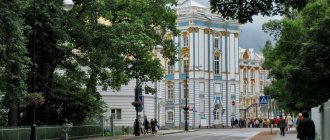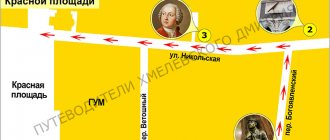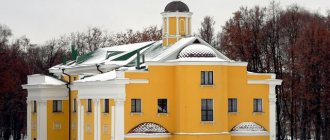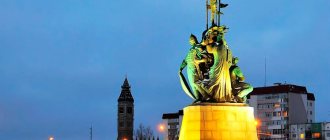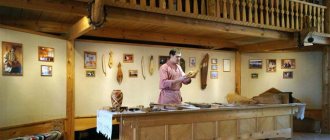The city of Pushkin is considered one of the greenest suburbs of St. Petersburg thanks to six parks, three of which are imperial. Local residents often call this place Tsarskoye Selo. After all, that’s what it was called centuries before the revolution, and now here is the State Museum-Reserve of the same name with two palaces.
Russian emperors chose this place at the beginning of the 18th century, establishing a residence here. At the beginning of the 19th century, when Alexander I reigned, Tsarskoe Selo was united with neighboring Sofia, receiving the status of a city. During Soviet times, this place became a Children's Village, and in 1937, on the anniversary of Pushkin's death, it received the name of the poet.
Catherine Palace
Address: st. Sadovaya, 7 (in Catherine Park) Telephone: Website: https://www.tzar.ru/museums/palaces/c_atherine Opening hours: 10:00–18:00, day off - Tuesday. Ticket sales from 10:00 to 16:45 (entrance to the exhibition until 17:00). During the autumn, winter and spring school holidays, tickets are sold from 12:00 to 16:45 (entry to the exhibition until 17:00). Cost: adults - 700 rubles, pensioners - 350 rubles, cadets, conscripts, members of the unions of artists, architects, designers of Russia - 350 rubles, pupils over 16 years old, students - 350 rubles, persons under 16 years of age - for free. Group excursion services in Russian are included in the entrance ticket price. The cost of excursion services for groups of free categories of visitors (from 10 to 30 people) is 3,000 rubles.
The Catherine Palace showcases the work of the best architects of the 18th century. During the years that the palace served as the residence of the kings, it was rebuilt several times. In its original form, back in 1724, it was small and was popularly called Catherine’s “stone chambers.”
During her reign, Elizabeth changed many architects and settled on Rastrelli. By his decision, the wooden galleries were changed, and the enfilade was rebuilt and stretched along the entire length of the palace. The chosen blue color was also unusual for those years, which was complemented by white paint and gilding, for the production of which 100 kg of gold were spent. By 1756, all sculptures were gold plated. At the same time, the Amber Room was modernized: gilding was added, paintings made of jasper and amber appeared.
Later, Catherine II rebuilt the building, ordered the gilding to be removed and the walls painted, and she created the Bedchamber, as well as the Arabesque and Lyon drawing rooms. The last two rooms have not yet been restored after destruction during the Great Patriotic War.
In total, almost 60 halls were destroyed during the war, of which only 32 have now been restored. Restoration of the palace continues to this day. The artists are proud of the restored Amber Room, an architectural masterpiece given to Peter I by the Prussian King Frederick William I and transported to Russia in 1717. During the war, the Amber Room disappeared without a trace, and the mystery of its disappearance has not yet been solved - according to one version, it burned down, according to another, it was stolen by German troops.
At the moment, in the Catherine Palace you can visit:
- Throne and Picture Halls
- Amber room
- Raspberry and Green Pillar, so named due to the colored pilasters
- White Front and Green dining rooms
- Waitress and Bedchamber
Reviews about the attraction
The Catherine Palace is an iconic place that you should definitely visit in Pushkin. Tourists leave the following positive reviews:
- a magnificent monument of history and architecture, which has been preserved in almost perfect condition;
- accurately recreated interiors;
- a huge number of interesting exhibits;
- beautiful big garden.
But there were some negatives:
- a lot of tourists, huge queues;
- the content and excitement of the excursion directly depends on the professionalism of the guide;
- expensive tickets (for Russians - 700 rubles, for foreigners - 1000 rubles);
- very large tour groups, which makes visiting the palace difficult;
- A short excursion, you have to look around the palace briefly.
Catherine Park
Address: st. Sadovaya, 7 Telephone: Website: https://www.tzar.ru/museums/palaces/catherine_park Opening hours: from September to April the park is open to the public from 7:00 to 21:00 , in May and June the park is open for visiting from 7:00 to 23:00, in July and August the park is open to the public from 7:00 to 22:00 Cost: from May to October - 150 rubles. (adult), 40 rub. (pensioner), 80 rub. (for students over 16 years old, members of creative unions of the Russian Federation, military personnel). Visitors under 16 years old are free. The cost of a one-month subscription for adults is 550 rubles, for pensioners - 450 rubles. In winter, admission is free.
Catherine Park united two parks of different styles: the regular Old Garden and the landscape English Park. According to legend, Peter I himself planted plane tree alleys and oak trees in the Old Garden. The garden was laid out on three ledges according to the plan of the Dutch masters. On the third elevation, Mirror Ponds were organized, and on the river - Verkhny and Melnichny ponds. The last of them is currently combined with a number of Lower Ponds cascading.
The sculptures decorating the park appeared during the reign of Elizabeth. The "Grotto" and the Hermitage Pavilion were designed by the architect Rastrelli, who also changed the shape of the Great Pond.
In the 70s of the 18th century, the Admiralty complex was built here, the Hermitage kitchen was built and “soaphouses” were built - the Upper and Lower Baths pavilions, that is, baths for the royal family. At the same time, architect V.I. Neelov began to lay out the second part of the park, called the English Park.
It is most convenient to buy tickets to the park in the Hermitage Kitchen building, next to which there is a parking lot. Here you can also purchase a ticket to visit the Catherine Palace and buildings inside the park - the Hermitage Pavilion, the Lower Bath, the Turkish Bath. Near the entrance there is an information board with a pointer to attractions.
Reviews about the attraction
Fedorovsky town is one of the most important attractions to visit in Pushkin. Here's what tourists say about this place:
- a very atmospheric place, imbued with the spirit of history;
- beautiful, sophisticated details of the structures;
- a lot of greenery, which is especially important in the summer;
- very quiet and not crowded, if compared with the same Catherine Park, where tourists walk in crowds.
Among the negative points it is worth noting the following:
- the buildings are not in the best condition, destruction is visible in places;
- The area does not look well maintained.
Alexander Palace
Address: st. Dvortsovaya, 2 (inside Alexander Park) Phone: Website: https://www.tzar.ru/museums/palaces/alex_ander.
In September 2015, the Alexander Palace Museum was closed for restoration work. The final completion of work on the Alexander Palace is planned no earlier than 2022.
The Alexander Palace was ordered to be built by Catherine the Great after the wedding ceremony of her grandson Alexander I. It was opened in 1796.
The palace is discreetly beautiful and is an example of classical style both outside and inside. Artificial marble was used to decorate the walls of the Front Enfilade, located along the garden facade of the palace. The dynamics are set by wide arches that divide this large hall into three parts:
- Semicircular hall (in the middle)
- Portrait (from the east)
- Billiard room (from the west)
To the left of the Front Enfilade are:
- Hall with a slide
- Library
- Corner living room
On the right side are:
- Yard Church
- Concert hall
- Living rooms
Not all of the interiors conceived by the architect Quarenghi have reached us, since some rooms were rebuilt in the 19th century. The courtyard of the palace also underwent reconstruction. Under Alexander I, it was paved with marble, but later the stone was replaced with a green lawn.
Reviews about the attraction
Among the photos of Pushkin’s attractions, the Alexander Palace takes a worthy place. Here's what you can hear about it from tourists:
- beautiful architecture and interior decoration;
- the exhibition includes many personal belongings of members of the royal family;
- affordable prices for excursions;
- After the excursion, you have the opportunity to walk around the museum and park on your own;
- The process of the museum is well organized, everything is provided for the convenience of tourists (wardrobe, storage lockers, toilets, and so on).
Here's the criticism:
- few restored halls;
- the excursion is very short;
- Not all guides can present information clearly and interestingly.
Alexandrovsky Park
Address: st. Dvortsovaya, 2 Telephone: Website: https://www.tzar.ru/museums/palaces/alexander_park Opening hours: 07.00-21.00 Cost: free admission
Alexander Park deservedly bears the name of Emperor Alexander I: the Tsar made it for himself, since he loved to walk there just like his grandmother Catherine the Great. The park occupies 200 hectares, and tourists usually get there through the Chinese Bridge, which is located at the entrance to the Catherine Palace. There is another entrance - the gate at the Alexander Palace.
The park consists of two parts: the Regular Park with regular alleys, flower beds, and well-groomed trees, and the English Park, which resembles a forest rather than a park.
While walking through the Regular Park, it is worth looking at:
- Bulk mountain "Parnassus"
- Curtain (earthen rampart) “Mushroom”
- Five Chinese style bridges
- Chinese village and theater
The attractions of the English (landscape) park are three ponds with funny names:
- Children's
- Kitchen
- Facade
The English part of the Alexander Park smoothly flows into the Farmer's Park, located next to the complex of buildings of the Imperial Farm. Fedorovsky Tsar's Cathedral, erected on the banks of the Kovshovaya Pond, is the main attraction of this part of the park.
How can you get to Tsarskoye Selo?
Electric trains run from Vitebsky railway station to Tsarskoye Selo station. The station was restored several years ago, and now it is a very atmospheric place. St. Petersburg residents specially come here for photo sessions
There are several ways to get from the center of St. Petersburg to Pushkin:
➢ By bus – number 187 goes from the Moskovskaya metro station to Pushkin. You need to get off at the Egyptian Gate stop, from there it’s a 20-minute walk to the entrance to the park
➢ By minibus - from the Kupchino metro station on minibus K-342 to the Alexander Palace stop in Pushkin. It’s a 10-minute walk to the entrance to the museum-reserve.
➢ By train – from Vitebsky railway station to Tsarskoe Selo station. Walking distance from the station - 20 minutes
➢ By car - in St. Petersburg there is Yandex.Drive, the cost of a trip to Pushkin is approximately 800-900 rubles. If you book a car for the whole day (so as not to look for a free car on the way home), you will have to pay 2,000-3,0000 rubles. Promo code refRhD173 will give you a 50% discount on your first trip
With an excursion - tourist buses regularly travel from St. Petersburg to Pushkin. The price for a standard tour, which usually includes a walk through the Catherine Garden and a visit to the palace, is +/-2,500 rubles per person
Memorial Museum-Lyceum (Tsarskoye Selo Lyceum)
Address: st. Sadovaya, 2 Telephone: Website: https://www.museumpushkin.ru Opening hours: 10.30 – 18.00, ticket office until 17.30. Day off is Tuesday. Sanitary day is the last Friday of the month. Opening hours of the Museum-Lyceum garden: Daily from 07:00 to 23:00 Cost: without excursion - 150 rubles. (adult), 60 rub. (pensioner), 40 rub. (students (full-time education) from 16 years old), free - children under 16 years old and schoolchildren under 18 years old. With excursion – 270 rubles. (adult), 180 rub. (pensioner), 180 rub. (students (full-time study) from 16 years old), 120 rub. (children under 16 years old).
The Tsarskoye Selo Lyceum is known to us as the school where A.S. was educated. Pushkin. “Our Fatherland is Tsarskoe Selo,” wrote the great poet. The educational institution opened in 1811 and accepted only children from noble families. Pushkin was included in the first intake of the Lyceum.
The educational institution is known for its traditions. After the final exams, the Lyceum staff broke the bell that used to gather students for classes. The fragments were distributed to graduates as a symbol of warmth and love for the students of the Lyceum. Alexander Pushkin's graduation also received rings with an inscription as a keepsake, which became a talisman for former lyceum students.
The museum recreates the atmosphere and spirit of the first edition of the Lyceum. Based on archival materials, museum workers created the Great Hall, the Newspaper Room, classrooms and a library room. Here you can see the students' bedrooms and the rooms of the tutor S.G. Chirikov, who lived half his life in the Lyceum. An exhibition has been opened within the museum’s walls to help you learn about the lives and destinies of graduates of the educational institution over the years.
The Egyptian Gates
When entering the city of Pushkin by car, you can see the Egyptian Gate. They are also called Kuzminsky Gate. Built in 1830 on the site of the former Bolshoye Kuzmino settlement at the entrance to Tsarskoe Selo. The decorative decoration includes motifs from Egyptian mythology. The cast iron elements of the gate were cast at the Aleksandrovsky Iron Foundry.
Location: at the entrance to Tsarskoe Selo, Pushkin,
Historical and Literary Museum of the City of Pushkin
Address: st. Leontievskaya, 28 Phone: Website: https://ilmp.ru Opening hours: daily from 10:00 – 17:30, Mon.-Tue. - weekend. The cash desk is open from 10:00-17:00 Cost: 120 rubles. (adult), 50 rubles (preferential categories). Excursion for one person - 1200 rubles, in a group of 2 to 10 people. inclusive - 120 rubles/per person, from 11 to 25 people. inclusive - 70 rub./per person. Interactive and thematic excursions - from 120 rubles.
The museum's exhibitions tell about life in Pushkin over the centuries. Photographs, historical documents, paintings and interior items help you immerse yourself in the old way of life. According to museum workers, visitors are impressed by the Tsarskoye Selo Tavern exhibition. The hall displays antique samovars, dishes and gramophones. At the box office you can get it for 800 rubles. order a tea party at the Tsarskoye Selo tavern.
Another feature of the museum is that from the windows of one of its halls there is a good view of the restored Catherine’s Church, which is considered the main temple of the city.
The museum staff organizes city sightseeing tours (on foot and by bus), as well as excursions dedicated to parks, cathedrals and other historical places of the city.
Cameron Gallery
A wonderful masterpiece of architecture. The light gallery floating above the park invites you to take a walk and feel like a part of that era. Decorated with fabulous floral arrangements and sculptures. The gallery offers beautiful views of the park design and floral compositions. Here you can often find a whole line of newlyweds and for good reason - the place is enchanting.
Location: Sadovaya, 7a, Pushkin, St. Petersburg
Babolovsky Palace and Park
Address: Krasnoselskoe highway, 65 (closest stop to the park and palace) Opening hours: open 24 hours Cost: admission free
Babolovsky Park is located northwest of Krasnoselskoye Highway. It’s worth coming here to look at the dilapidated Babolovsky Palace with a huge stone bathtub and the Taitsky water conduit.
The park got its name from the Finnish village of Pabola (Babola), on the site of which it is located. Later, when this land became Russian, a pond was dug here, the swamps were drained, and shrubs and deciduous trees were planted. The founder of this landscape park is considered to be the architect I.V. Neelov.
In the middle of the 18th century, by decree of Empress Catherine II, the Taitsky water pipeline was laid through the park, coming from the springs of the Taitsy hill. At first it consisted of wooden channels, then they were lined with stone. According to legend, Catherine II considered this water beneficial and drank only it. Under the empress, a wooden house was first built for Prince G.A. on the territory of Babolovsky Park. Potemkin, and then a one-story stone palace with seven rooms and a large bathhouse.
A bathtub that could hold 8,000 buckets of water was built from a single piece of granite in the palace by Alexander I, who loved bathing in cold water. For these purposes, the bathhouse was rebuilt. The palace was also used for other purposes: it is believed that it was within its walls that Alexander met one of his favorites.
Unfortunately, during the Great Patriotic War, the park's buildings and hydraulic structures were seriously damaged. However, the Tsar Bath remained standing within the dilapidated walls, and you can look at it through the lancet window of the palace.
Fragments of the Taitsky water conduit have been preserved in the area of the Babolovsky Palace. At the end of the 80s, they tried to restore the water pipeline, but the event ended in failure.
Reviews about the attraction
When asked about where to go in Pushkin, many experienced tourists will give you a recommendation regarding the historical and literary museum. Here's what they say about the merits of this place:
- many interesting exhibits and photographic materials;
- the museum often hosts very educational lectures;
- beautiful historical building;
- friendly employees who sincerely love their brainchild.
Here are the disadvantages:
- The museum's exposition cannot be called spectacular, so if you are not interested in history, you will be bored here.
Feodorovsky Sovereign Cathedral
Address: Academic Avenue, 34 Telephone: (office), +7(812)466-61-69 (on duty) Website : https://gosudarevsobor.cerkov.ru Opening hours: 09:00 (Saturday and Sunday. from 7.30) –18:50. On Christmas, Easter, on the Day of Remembrance of the Royal Martyrs (July 17) and some holidays - around the clock. Cost: free entry
Feodorovsky Cathedral is located in the lower part of Alexander Park, where the Farmer Park begins. It was built for officers of the Imperial Consolidated Regiment and Convoy. It is believed that the place for the temple was chosen by Nicholas II himself, who laid the first foundation stone.
Architect V.A. By order of the emperor, Pokrovsky created a one-domed cathedral, somewhat reminiscent of the Moscow Annunciation Cathedral. The temple has not only an upper, but also a lower church, where services were held for the royal family in the winter. At the beginning of the 20th century, ordinary people were allowed to enter the temple only during Orthodox holidays, and then only by special invitation.
Nicholas II planted oak trees near the Feodorovsky Cathedral in honor of the birth of his children. A monument to the emperor was subsequently erected at this site.
The temple was opened to visitors only after the revolution, but during the Stalin era it was converted into a cinema, leaving the dome and external decoration. The building was seriously damaged during the war and was restored only in 1995. The cathedral is known among believers for its revered copy of the Feodorovskaya Icon of the Mother of God.
What should I do if I’m alone (there are two or three of us), but I want to go on an excursion?
There's no problem. All excursions are divided into three types:
— group for already independently formed groups. Let’s say you and your friends or family or work team got together and decided to chip in and buy an excursion;
- individual . As they say, it depends on taste and color - route, schedule, duration. There are standard, ready-made offers from guides. They can be tailored to your specific needs, including changes in program and other details;
- prefabricated . This is exactly your case. Something between group and individual. A guide or travel agency conducts an excursion on a certain day and at a certain time for everyone who applies for it. They gather individuals and form them into a group for the trip. It doesn’t matter how many of you there are, whether you are alone or with friends/family, you join a team that all travels together according to a certain program at a certain time.
